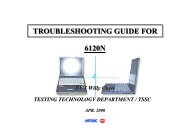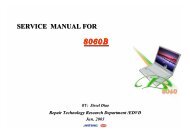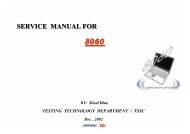Mitac 8080 Service Manual - laptop schematics, notebook ...
Mitac 8080 Service Manual - laptop schematics, notebook ...
Mitac 8080 Service Manual - laptop schematics, notebook ...
You also want an ePaper? Increase the reach of your titles
YUMPU automatically turns print PDFs into web optimized ePapers that Google loves.
<strong>8080</strong> N/B Maintenance<br />
5.2 Intel 82855GM Graphics and Memory Controller Hub (GMCH)<br />
Host Interface Signals (Continued)<br />
Signal Name Type Description<br />
HREQ[4:0]# I/O<br />
AGTL+<br />
HTRDY# O<br />
AGTL+<br />
RS[2:0]# O<br />
AGTL+<br />
Host Request Command: Defines the attributes of the request.<br />
HREQ[4:0]# are transferred at 2x rate. Asserted by the requesting<br />
agent during both halves of the Request Phase. In the first half the<br />
signals define the transaction type to a level of detail that is<br />
sufficient to begin a snoop request. In the second half the signals<br />
carry additional information to define the complete transaction type.<br />
Host Target Ready: Indicates that the target of the processor<br />
transaction is able to enter the data transfer phase.<br />
Response Status: Indicates type of response according to the<br />
following the table:<br />
RS[2:0] Response type<br />
000 Idle state<br />
001 Retry response<br />
010 Deferred response<br />
011 Reserved (not driven by MCH-M)<br />
100 Hard Failure (not driven by MCH-M)<br />
101 No data response<br />
110 Implicit Write back<br />
111 Normal data response<br />
DDR SDRAM Interface Signals<br />
Signal Name Type Description<br />
SCS [3:0]# O<br />
SSTL_2<br />
SMA[12:0] O<br />
SSTL_2<br />
SBA[1:0] O<br />
SSTL_2<br />
SRAS# O<br />
SSTL_2<br />
SCAS# O<br />
SSTL_2<br />
Chip Select: These pins select the particular DDR SDRAM<br />
components during the active state.<br />
Note: There is one SCS# per DDR-SDRAM Physical SO-DIMM<br />
device row. These signals can be toggled on every rising System<br />
Memory Clock edge.<br />
Multiplexed Memory Address: These signals are used to provide<br />
the multiplexed row and column address to DDR SDRAM.<br />
Bank Select (Memory Bank Address): These signals define which<br />
banks are selected within each DDR SDRAM row. The SMA and<br />
SBA signals combine to address every possible location within a<br />
DDR SDRAM device.<br />
DDR Row Address Strobe: SRAS# may be heavily loaded and<br />
requires tw0 DDR SDRAM clock cycles for setup time to the DDR<br />
SDRAMs. Used with SCAS# and SWE# (along with SCS#) to<br />
define the System Memory commands.<br />
DDR Column Address Strobe: SCAS# may be heavily loaded and<br />
requires two clock cycles for setup time to the DDR SDRAMs.<br />
Used with SRAS# and SWE# (along with SCS#) to define the<br />
System Memory commands.<br />
Signal Name Type Description<br />
SWE# O<br />
SSTL_2<br />
SDQ[71:0] I/O<br />
SSTL_2<br />
SDQS[8:0] I/O<br />
SSTL_2<br />
SCKE[3:0] O<br />
SSTL_2<br />
SMAB[5,4,2,1] O<br />
SSTL_2<br />
SDM[8:0] O<br />
SSTL_2<br />
RCVENOUT# O<br />
SSTL_2<br />
RCVENIN# I<br />
SSTL_2<br />
Write Enable: Used with SCAS# and SRAS# (along with SCS#) to<br />
define the DDR SDRAM commands. SWE# is asserted during<br />
writes to DDR SDRAM. SWE# may be heavily loaded and requires<br />
two clock cycles for setup time to the DDR SDRAMs.<br />
Data Lines: These signals are used to interface to the DDR<br />
SDRAM data bus.<br />
NOTE: ECC error detection is supported: by the SDQ[71:64]<br />
signals.<br />
Data Strobes: Data strobes are used for capturing data. During<br />
writes, SDQS is centered on data. During reads, SDQS is edge<br />
aligned with data. The following list matches the data strobe with<br />
the data bytes.<br />
There is an associated data strobe (DQS) for each data signal (DQ)<br />
and check bit (CB) group.<br />
SDQS[7] -> SDQ[63:56]<br />
SDQS[6] -> SDQ[55:48]<br />
SDQS[5] -> SDQ[47:40]<br />
SDQS[4] -> SDQ[39:32]<br />
SDQS[3] -> SDQ[31:24]<br />
SDQS[2] -> SDQ[23:16]<br />
SDQS[1] -> SDQ[15:8]<br />
SDQS[0] -> SDQ[7:0]<br />
NOTE: ECC error detection is supported by the SDQS[8] signal.<br />
Clock Enable: These pins are used to signal a self-refresh or power<br />
down command to the DDR SDRAM array when entering system<br />
suspend. SCKE is also used to dynamically power down inactive<br />
DDR SDRAM rows. There is one SCKE per DDR SDRAM row.<br />
These signals can be toggled on every rising SCK edge.<br />
Memory Address Copies: These signals are identical to<br />
SMA[5,4,2,1] and are used to reduce loading for selective<br />
CPC(clock-per-command). These copies are not inverted.<br />
Data Mask: When activated during writes, the corresponding data<br />
groups in the DDR SDRAM are masked. There is one SDM for<br />
every eight data lines. SDM can be sampled on both edges of the<br />
data strobes.<br />
NOTE: ECC error detection is supported by the SDM[8] signal.<br />
Clock Output: Reserved, NC.<br />
Clock Input: Reserved, NC.<br />
85





